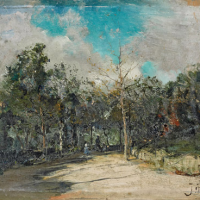22. IVAN PAVLOVICH POKHITONOV

The life story of Ivan Pokhitonov is as rich as the paintings he produced in a long career. Born in the Ukraine to a family that had been granted patents of nobility in the 18th century, Pokhitonov began drawing and copying while at school. Although he later studied at Petrovsky Agricultural College in Moscow, and participated in and got in trouble with the authorities for radical politics, it was a visit to Switzerland in 1871-2 with his mother and his convalescing sister that provided him with his first opportunity to exhibit and sell his art. After returning to work on the family estate, he becomes acquainted with recent developments in Russian art by visiting the Peredvizhniki exhibition which was touring in nearby Yelizavetgrad, and it was this visit that confirmed his intention to make a career as an artist.
In 1877 he moved to France, and in the following years used his home in Paris as a base for painting trips to Barbizon, outside Paris, and beyond, as well as periodic trips home to Russia. The Russian expat community in Paris was diverse and stimulating. Pokhitonov became friendly with writer Ivan Turgenev, whose portrait he painted in 1882. The cosmopolitan circle of artists he mixed with included the Australian John Peter Russell (1858-1930), who lived in the same building, and Russells friend Vincent van Gogh (1853-1890).1 He later moved to Belgium where he settled with his family near Lige. At the height of public interest in his work, he was a regular exhibitor at the Paris Salon and signed a lucrative contract with one of the most important Paris art dealers of the era, Georges Petit.
Pokhitonovs method of working has been a source of fascination for anyone coming into contact with it. The painstaking process of painting, scraping back and re-applying oil paint on a miniature scale belies the remarkable clarity and freshness of his vision. His ability to capture the visual characteristics of a place at a specific time of the year, season and day is unique. While he lived and worked in Paris and was clearly acquainted with many of the leading protagonists of recent developments in French art, his work remains distinctively his own, and in its poetic expressiveness and mood, Russian. The present painting is a typical example. It is a small painting but conveys a great deal of information: an attractive breezy day, of mixed clouds and sunshine, with a path through some woods. On the path a group of figures. A woman and two children, along with their small white dog (possibly a West Highland White Terrier), depicted partly in shade and partly in the direct light of the sun, all painted so finely and on such a small scale as to be barely registerable by the naked eye, yet unmistakable. The father of the family is not present, unless his presence takes the form of the artist himself, recording the scene, in which case the painting may be a depiction of his own family.
The present painting came to Australia after World War II as part of the household effects of a Russian family now resident in Melbourne.
Footnotes
1. The intriguing possibilities of the friendship, through Russell, between Pokhitonov and van Gogh has been the subject of extensive research, numerous articles, and an entire book. In particular, the famously downgraded Portrait of a Man, acquired by the National Gallery of Victoria in 1940 as by Vincent van Gogh, is thought to be a portrait of Pokhitonov. For further reading see: Landais, B., Un van Gogh aux Orties, le Portrait de Pokhitonov, Createspace Publishing, United States of America, 2014.
Timothy Abdallah BA